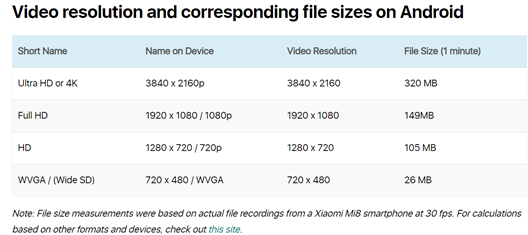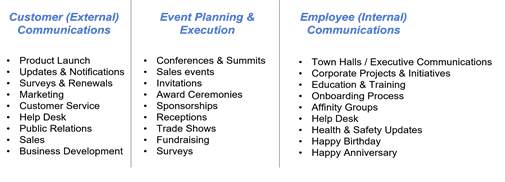Why Now is Good Time for Video-in-Email
Since the first email was sent in 1971, as a community, we have continuously reflected on how we think about communicating with each other. Video-in-email further enhances the day-to-day email engagement and with recent technology advances, our current industry standard definition for video-in-email will soon be re-written.
We will explore the video-in-email experience for Business to Consumer (B2C). Previously, B2C brand engagement was limited to television, the viewer could engage with high-definition quality and sound (e.g. television commercials or infomercials). This experience increases the consumer’s excitement, prompting the consumer to purchase a product or service. Yet this brand engagement was limited to a few digital channels that could support that level of high-definition media quality. As a result, a true 360-degree brand experience wasn’t connecting with the consumer across all of the same media channels the consumers were utilizing.
With video-in-email, this same excitement can now carry forward, with similar levels of engagement, directly into the consumer’s email inbox, a channel not yet fully realized to its fullest potential.
Why now? The concept of an online video has been around for quite a while. In 2014, the HTML 5.0 video standard was adopted and lay the foundation for the media standard to play various types of media on most web pages without a browser plug-in. This new online standard cleared the path to expand the capabilities of video-in-email.
Current Industry Definition
Today, the industry definition of video-in-email is a ~5 second animated .gif or an image with a play symbol (i.e., the triangle), representing a smaller clip or snippet of the original video. The animated image is pasted or embedded into the email before sending. The consumer opens the email, clicks the animated image, and is taken to an external website where they can now view the entire video.
Industry Workaround
The reason for this industry workaround is primarily due to the size of the video. As an example, the Hippo Video shown here is a 5 second animated clip recorded with high quality, at 3.29 MB in size. The better the recording quality, the higher the file size. Vido4change (2020) also emphasizes the size of the video can vary based on image quality and also how the image was recorded (i.e., mobile phone, digital camera). As video quality becomes better with technology, such as the recent creation of 4K or ultra-HD, it only increases the size of the video creating a perpetual challenge.
Workaround Challenges
Other challenges may include the corporate firewall, which limits the total file size of external emails (i.e. emails originating from outside the company), to no more than 2 MB. In these scenarios, the 5 second animated clip would not be an option as the email would not reach the consumer.
Within the last 12 months, due to an increase in work from home, some companies have increased the total email file size up to 10 MB, but additional obstacles for video-in-email may occur due to security features for accessing external websites.
In these scenarios, the 5 second animated clip above would reach the consumer, however when the consumer clicked the image to view the full video, the site may be blocked as part of a company policy. As a result, the use of personal email addresses has become quite favorable when using video-in-email, to reach the targeted consumer.

A Primary Communication Tool
Video-in-email is on the right path to become the primary method for communication. What was once a novel trend is quickly becoming the standard. Recent surveys, prior to and post COVID, show similar patterns. Consumers strongly prefer a video experience over normal email and text. In 2016, a Facebook executive predicted their platform would be all video and no text by 2021(Quartz). More recent survey results are validating that prediction was not too far off:
- 81% of businesses use video as a marketing tool — up from 63% over 2020 (Hubspot )
- In 2020, viewers retain 95% of a message when they watch it in a video, compared to 10% when reading it in text (Wordstream )
- 59% of executives say they would rather watch a video than read text (Wordstream )
- 72% of customers would rather learn about a product or service by way of video (HubSpot)
- In 2020, 6 out of 10 people would rather watch online videos than television (Biteable )
- Users view more than 1 billion hours of video each day on YouTube (YouTube)
- People are 1.5 times more likely to watch video on their mobile phones(Facebook)
Value of Video-in-Email
The value of video-in-email certainly outweighs any of the known challenges. If you have not explored the possibilities of video-in-email, it…
…enables the personalized experience
- Provides an opportunity to hear & see a real person speak
- Is more interesting than 5 paragraphs of black and white text
- Allows for tone, urgency, sincerity, and other vocal nuisances which are lost in traditional email
- Up to 95% of the content, in a video, can be retained by the viewer, versus ~10% is retained when reading an email (Wordstream)
…creates immediate value:
- Captures the attention your audience in the first 10 seconds
- Increases the percentage of your audience who will remain engaged throughout the entire message
- Offers for a larger amount of content to be consumed and absorbed versus standard text
- Adding video content to emails can potentially reduce opt-outs by 75% (Backlinko)
…elevates digital marketing:
- Expands the audience to include those who consume information visually
- Raises the level of excitement about a product / service by providing a fuller experience with sound e.g., music, sound effects
- Enables a consistent brand message through all channels which was once limited to YouTube, television, and website
- Eight in 10 people will remember a video advertisement for the next 30 days (TechJury)
…has endless use cases:

Future of video-in-email
Video-in-Email is just a stepping stone in the long-term future vision. Once true play of video-in-email is conquered, that technology opens the door for a wider variety of use cases.
- In 2022, we expect the new standard will be the delivery of a full length or 100 seconds of a 4K video, in the email direct to the consumer. The video will play in the email inbox with no downloads, clicks or hyperlinks to external sites. This means the consumer can view the video upon opening the email and interact with the call-to-action buttons more quickly.
- In 2022-2023, once video-in-email can play directly in the inbox, we expect consumers will experience the merging of machine learning and AI concepts as part of the video-in-email engagement. For example, instead of receiving a text email about a past due bill, a video avatar would communicate your current payment status and provide information specific to you. This experience would have a more positive impact on the consumer who listens to the video and learns of available payment options that were lost in the fine print from the original email text.

 How to resolve AdBlock issue?
How to resolve AdBlock issue? 
